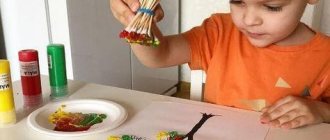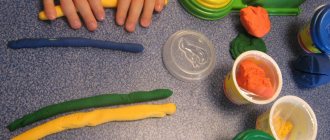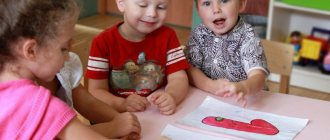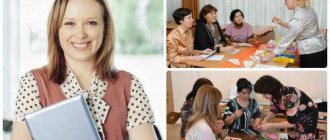Abstract of GCD for the senior group, using non-traditional appliqué techniques.
Completed by: Kozyreva Marina Petrovna.
Place of work: Ulyanovsk, MBDOU TsRR d\s No. 14
Position: Educator.
Abstract of GCD for the senior group, on non-traditional application.
Lesson topic:
"Magic squirrel"
Purpose of the lesson:
To familiarize children with one of the types of non-traditional appliqué techniques.
Objectives:
Getting to know a new technique - gluing finely chopped threads onto a silhouette;
Training in dexterity in handling various materials;
Development of the ability to work hands with visual perception;
Development of imagination and creative activity;
Development of memory, attention, thinking, speech, eye, cognitive interest;
Cultivate perseverance, accuracy, goodwill, and the ability to work in a team and individually.
Equipment:
Sample of work, an envelope with a silhouette of a squirrel, glue, a brush, a napkin, scissors, felt-tip pens, a basket with balls of thread of different colors, a squirrel toy, a laptop with a presentation “photos of squirrels.”
GCD move:
Teacher (B):
Guys, an interesting guest came to our lesson today, and you will find out who it is if you guess the riddle:
It jumps from branch to branch, but rarely comes down to the ground. The small, fragile body always wears a fur coat. The claws on the paws are sharp: It’s not easy to run up the trunk! This red-haired... (squirrel) (a toy squirrel appears from behind the screen).
IN:
Meet guys, this is a squirrel and her name is Bella. Oh, and our squirrel didn’t come with empty paws, she brought something, but what will you learn from the riddle:
Followed by needles, well known to everyone, cannot walk ahead, a needle will pave the way for her ( thread)
IN:
Well done guys, you got it right!
Our Bella brought with her a whole basket of balls. Let's look at them and touch them. Who can tell what kind of balls these are? What can be made from them? (children's answers)
Q:
Guys, do you know that Bella came to us for a reason, she came to us for help.
For her birthday, she decided to make a photo album with photos of all her squirrel friends. What color do you think squirrels can be? Let's watch a presentation of photographs of our Bella's friends (on a laptop, the teacher shows various pictures of squirrels of different colors, discussing their appearance with the children).
IN:
Bella was so happy with the photographs she took, but they turned out to be black and white
(showing the children a printed silhouette of a squirrel from an envelope)
Q:
That's why Bella came to us for help.
After all, photographs should be colored, bright and not black and white. How can we help her? (children's answers). Q:
Do you remember what Bella brought with her?
She brought us her favorite basket of balls. Why did she bring it? (children's answers). Q:
That’s right, guys, today we will help our Bella and make an unusual applique, and the applique using chopped threads, so we will make her black and white squirrels colored!
Unconventional technique of appliques from different types of cereals
Author: Sotnikova Svetlana Anatolyevna,
teacher of the highest qualification category
MADO CRR-kindergarten No. 158 in the city of Tyumen.
Topic: “Unconventional technique of applications from different cereals”
Goal: To introduce teachers to the non-traditional technique of appliques from different cereals. Show techniques and stages of application.
Objectives: Learn to create images using various grains. Correctly, evenly place the composition on a sheet of paper. Encourage teachers to use non-traditional cereal appliqué techniques to develop children's creativity, imagination, tactile sensation, fine motor skills and creative potential, as well as the ability to work and achieve the desired result. Develop thinking, speech, accuracy, volitional qualities such as attention, endurance, perseverance. The ability to develop interest in artistic and aesthetic activities. Support the creative abilities of teachers and increase their self-esteem.
Equipment: Various cereals, trays, plasticine, napkins, stacks, A4 sheets with drawn compositions.
Preliminary work:
Planting cereals, experience with cereals
Part 1 - introductory.
Application from cereals brings novelty to our activities, makes it interesting and exciting. Teaches to distinguish colors, shapes, improves the eye. The application is of great importance for the comprehensive development and education of preschool children.
® In mental education – forms mental operations, analysis, synthesis, comparison, generalization, and develops children’s speech. Children master the correct verbal designations of directions (left, right, middle, corners, top, bottom).
® In sensory education - direct, sensitive acquaintance with objects and phenomena.
® In moral education - develops moral and volitional qualities: to bring the work started to the end, to study with concentration and purpose, to help a friend, to overcome difficulties.
® In labor education, it develops hard work. Children prepare the material for application and put it away.
® In aesthetic education – develops artistic taste.
Part 2 main.
Apply plasticine to the composition, choosing the desired color. Sprinkle with cereal, choosing the desired color and volume. Press the cereal into the plasticine with your fingers. If necessary, you can make the necessary additions to the image with plasticine.
Part 3 is final.
Exhibition of works.
Presentation of previously completed children's work.
Bibliography:
1. Adzhi, A. V. Notes of integrated classes in the senior group of kindergarten. Cognitive development. / A.V. Aji. - M.: TC "Teacher", 2006. - 336 p.
2. Take care of living things. Game didactic material on ecology. - M.: St. Petersburg. [and others]: Peter, 2013. - 196 p. 3. Bykova, N.M. Games and exercises for speech development / N.M. Bykova. - M.: Detstvo-Press, 2010. - 160 p. 4. Volkov, B. S. Teaching young children to communicate. Methodical manual / B.S. Volkov, N.V. Volkova. - M.: Sfera, 2013. - 128 p. 5. Volchkova, V. N. Lesson notes in the senior group of kindergarten. ISO. Practical guide for educators and methodologists of preschool educational institutions / V.N. Volchkova, N.V. Stepanova. - M.: TC "Teacher", 2008. - 873 p. 6. Gallery of emotions. What are you feeling now? Psychological poster. - M.: Genesis, 2015. - 800 p. 7. Gladysheva, N. N. Teacher’s work program. Daily planning of educational activities with children 3-7 years old in a mixed age group. March-May / N.N. Gladysheva, I.N. Khramov. - M.: Uchitel, 2014. - 168 p. 8. Emelyanova, E. L. Tell children about nature. / E.L. Emelyanova. - M.: Mozaika-Sintez, 2012. - 241 p. 9. Ilyina, S.K. Lekoteka in a preschool educational institution. Organization, documentation / S.K. Ilyina. - M.: Sfera, 2011. - 128 p.
“Certificate of publication in the media” Series A No. 0005837
We invite teachers of preschool education in the Tyumen region, Yamal-Nenets Autonomous Okrug and Khanty-Mansi Autonomous Okrug-Yugra to publish their teaching materials: - Pedagogical experience, original programs, teaching aids, presentations for classes, electronic games; — Personally developed notes and scenarios of educational activities, projects, master classes (including videos), forms of work with families and teachers.
Why is it profitable to publish with us?
1. “Kindergartens of the Tyumen Region” is an officially registered specialized media outlet at the federal level. 2. The activities of the editorial office are supported by the Department of Education and Science of the Tyumen Region 3. We issue a “Certificate of Publication” in the media. 4. The document has a unique number, is entered in the register, has the original seal of the editorial office of the online publication and signature. 5. “Certificate of publication” in the media is sent to the author in both paper and electronic versions.
Details >>>
Sample “Certificate of publication of author’s methodological material in the media.”pdf
Share





